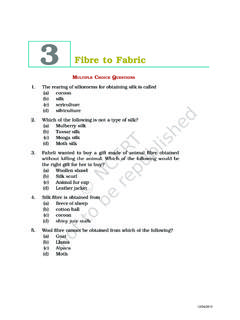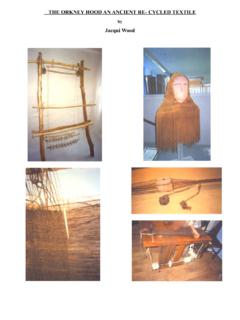Transcription of Weaving: The Complete Process From Thread to …
1 March 2005 Copyright 2005 Three Springs Handworks. All rights : The Complete ProcessFrom Thread to ClothSandra Rude, Textile ArtistThree Springs often ask me. How long did it take to weave that? The answer I usually give is that the actual weaving , that is, the act of throwing a shuttle back and forth across the loom, is about 10 percent of a complex Process . This Process includes a lot of planning and preparation before the weaving phase begins, and a number of finishing steps after the last Thread is reason for writing this document is to make it easier for anyone who is not a weaver to understand the Process and to visualize the steps that are necessary to the 2005 form Follows FunctionForm Follows FunctionThe first step in any weaving project is to decide what the cloth s purpose in life will be.
2 The intended function of the cloth guides the weaver in choosing the appropriate Thread or yarn. For example, the yarn I use to weave a rug needs to be thick and hard-wearing, and the cloth must be stiff and flat. It must not roll up at the edges and trip everyone who walks on it, or if it is to be hung as decorative art, it must lie flat against the wall. A scarf, on the other hand, or any cloth worn next to the skin, should be smooth, soft, and very drapey so it conforms to the I weave primarily scarves and shawls, and my personal preference is for fine rather than bulky cloth , I choose very thin Thread in natural fibers that are comfortable to wear next to the skin.
3 Silk, lyocell, rayon, cotton, and fine soft wool such as Merino are good choices. There is no set standard for the size of a scarf - some people prefer long and narrow, others prefer a shorter, wider shape. The size of the wearer makes a difference, too. At six feet tall, I am likely to wear a longer, wider shawl than a woman five feet tall. Some women like to do the Isadora Duncan fling, with a dramatically long scarf wrapped around the neck once or twice. Some scarves look best simply draped over the shoulders. Some scarves have long, twisted fringe, others have short, straight fringe or just a simple any case, I must make decisions about length and width and end treatment before starting to weave, because these factors determine the amount of Thread I ll need.
4 The design, or pattern, of the cloth also has an impact. What s the scale of the pattern? Do I choose a nonrepeating pattern? Two repeats? Ten repeats? Fifty repeats?Once I ve decided what Thread to use, I use two kinds of software to help in the planning and design phase: A spreadsheet helps me calculate the amount of yarn I ll need. You ll see an example in Figure 1 on the facing page. weaving software lets me program the design of the cloth into the computer. Later, this same software will send the finished design to another computer attached to the loom. This means I don t have to remember each step of the design - which can be more than 2,000 threads long - the computer remembers it for me.
5 Hey, this is why God made computers! Figure 2 shows an example of a design that you will see throughout this document in various Follows FunctionCopyright 20053 Figure 1. Spreadsheet for yarn calculationFigure 2. weaving design software4 Copyright 2005 Dyeing the ThreadDyeing the ThreadI usually buy undyed Thread that is wound onto large cardboard cones. I must measure off the number of yards I ll need, based on the spreadsheet (with a bit extra just in case) and make skeins for dyeing. Then I get to play in the dye-pot! The pictures on the next page show the dye Process at various stages.
6 For the project I m planning, there will be two colors of warp threads, alternating Thread by Thread , so I ll dye half the warp yardage on one color, and half in the other. In this case, the colors are medium blue and deep 3. Cone of white Thread and a measured skeinDyeing the ThreadCopyright 20055 Figure 4. Skein, pot, and dye suppliesFigure 5. Mixing dyeFigure 6. Skein in dye-pot6 Copyright 2005 Winding the Warp ThreadsWinding the Warp ThreadsThe warp, that is, the lengthwise threads in the cloth , must be measured out to the correct length for my project, and the threads must be kept in order so that they can be wound onto the loom properly.
7 Since it s awkward to wind a warp with fine threads directly from a skein, I must first wind the Thread back onto a cardboard cone. Then I begin winding the warp using a warping mill. Each Thread follows the same path (based on a guide Thread that is the same length as the warp will be) and is kept in order through the whole 7. Winding Thread onto a coneFigure 8. Winding the warp on a warping millWinding the Warp ThreadsCopyright 20057 Once all the threads are measured out to the right length, and in the right order, I put a rod through the loop at one end of the warp and spread the threads out in a toothed board called a raddle.
8 This allows me to get the warp onto the loom at the width of the finished project. Then I begin winding the warp onto the two sticks in Figure 12 maintain the threading cross, which helps keep those warp threads in the same order as I placed them on the warping 9. Spreading the warp in the raddleFigure 10. Winding the warp onto the warp beamFigure 11. Warp brought forward over warp rollerFigure 12. The threading crossthrough the raddle8 Copyright 2005 Winding the Warp ThreadsHere s a simplified drawing of the loom, so you can see the essential parts of the loom, and the path of the warp I begin what is for me one of the most tedious (but most important) parts of the whole Process : threading the warp through the heddles on the shafts.
9 Each warp Thread must go through the eye of a heddle attached to the appropriate shaft, according to the pattern design. If I make a mistake here, there will be an unsightly break in the pictures on the next page show threading the heddles, drawing the threads through the reed, and tying the warp threads onto the apron rod. (The apron is a sheet of canvas that initially follows the path shown in green above. As weaving progresses, the apron and then the woven cloth wind onto the cloth storage beam at the back of the loom.) After tying on, I weave a few rows of waste yarn to check that the threading is correct and to space the warp threads warp threadsWoven clothCloth storage beamWarp rollerWarp beamPattern controllerShafts (24) and heddles Beater and reedFront beamFront of loomBack of loomCloth rollersFigure 13.
10 Essential parts of the loomWinding the Warp ThreadsCopyright 20059 Figure 14. Threading the heddlesFigure 15. Threading (close-up)Figure 16. Drawing threads through the reedFigure 17. Warp lashed onto apron rod; waste yarn woven inwith reed hook10 Copyright 2005 WeavingWe a v i n gOkay, now we ve almost gotten to the fun part - weaving ! First, I wind weft yarn onto a pirn, which fits into the fly-shuttle. The shuttle will carry the weft yarn across the loom, in the space created between threads that are raised and threads that are the way, I never warp the loom for a single scarf.

